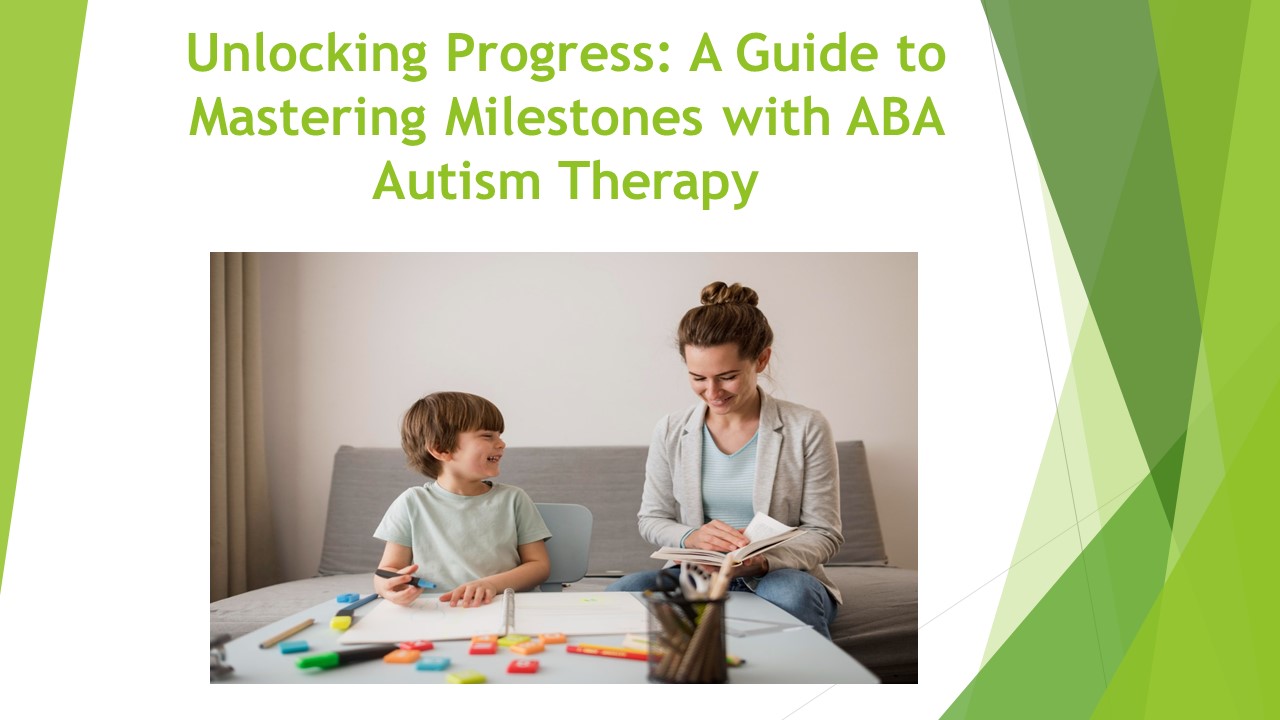Unlocking Progress: A Guide to Mastering Milestones with ABA Autism Therapy - PowerPoint PPT Presentation
Title:
Unlocking Progress: A Guide to Mastering Milestones with ABA Autism Therapy
Description:
Navigating the journey of Autism Spectrum Disorder (ASD) can be challenging, both for individuals on the spectrum and their families. However, with the right strategies and therapies, progress and milestones become achievable. One such effective intervention is Applied Behavior Analysis (ABA) Autism Therapy. In this comprehensive guide, we'll delve into the world of ABA therapy, offering valuable tips to help individuals with autism reach and conquer important milestones. – PowerPoint PPT presentation
Number of Views:3
Title: Unlocking Progress: A Guide to Mastering Milestones with ABA Autism Therapy
1
Unlocking Progress A Guide to Mastering
Milestones with ABA Autism Therapy
2
- Navigating the journey of Autism Spectrum
Disorder (ASD) can be challenging, both for
individuals on the spectrum and their families.
However, with the right strategies and therapies,
progress and milestones become achievable. One
such effective intervention is Applied Behavior
Analysis (ABA) Autism Therapy. In this
comprehensive guide, we'll delve into the world
of ABA therapy, offering valuable tips to help
individuals with autism reach and conquer
important milestones. - 1. Understanding ABA Autism Therapy A Foundation
for Progress - Before delving into tips for mastering
milestones, it's crucial to understand the core
principles of ABA Autism Therapy. ABA is a
scientifically proven approach that focuses on
behavior modification. It identifies and analyzes
specific behaviors, breaking them down into
smaller components to better understand and
address them. By employing positive
reinforcement, ABA aims to increase desired
behaviors and reduce unwanted ones. Understanding
these basics lays the foundation for implementing
effective strategies.
3
- 2. Personalized Goals for Targeted Progress
- ABA therapy emphasizes individualized plans
tailored to the unique needs of each person with
autism. To maximize progress, set clear and
realistic goals based on the individual's
strengths and challenges. Whether it's improving
communication skills, enhancing social
interactions, or managing sensory sensitivities,
personalized goals provide a roadmap for
achievement. Regularly reassess and adjust these
goals as progress occurs, ensuring that the
therapy remains dynamic and responsive to
evolving needs. - 3. Consistency is Key Establishing Routine and
Structure - Individuals with autism often thrive in
environments with clear routines and structures.
Consistency is a cornerstone of ABA therapy,
promoting a sense of predictability and security.
Establish a daily schedule that incorporates
therapy sessions, academic activities, and
leisure time. Consistent routines not only
enhance the effectiveness of ABA interventions
but also contribute to overall well-being by
reducing anxiety and stress. - 4. Harnessing the Power of Reinforcement in ABA
Therapy - Positive reinforcement plays a pivotal role in
ABA Autism Therapy. Identify meaningful rewards
that motivate the individual, reinforcing desired
behaviors. These rewards can range from verbal
praise and tokens to preferred activities or
items. By consistently pairing positive
reinforcement with target behaviors, ABA creates
powerful associations that encourage repetition
of those behaviors. Tailor reinforcement
strategies to the individual's preferences to
ensure they remain motivating and effective.
4
- 5. Building Social Skills through ABA
Interventions - Social skills are integral to successful
interactions and relationships, and ABA therapy
provides targeted interventions to develop these
crucial abilities. Incorporate social skills
training into daily activities, focusing on areas
such as initiating conversations, maintaining eye
contact, and understanding non-verbal cues. Use
role-playing scenarios to practice and reinforce
social skills in a controlled setting, gradually
transitioning these skills to real-world
situations. ABA's systematic approach ensures a
comprehensive and effective method for building
and refining social abilities. - 6. Collaborative Approach Involving Family and
Caregivers - ABA therapy extends beyond clinical settings,
emphasizing the importance of collaboration with
family and caregivers. Work closely with parents,
siblings, and other individuals involved in the
individual's daily life. Provide training and
support to ensure consistency in implementing ABA
strategies across different environments. This
collaborative approach enhances the
generalization of skills, enabling the individual
to apply what they've learned in various
settings.
5
- Conclusion
- Mastering milestones with ABA Autism Therapy
requires dedication, understanding, and a
personalized approach. By comprehensively
embracing the principles of ABA, individuals with
autism can make significant progress in their
developmental journey. From setting personalized
goals to incorporating consistent routines and
harnessing the power of positive reinforcement,
ABA therapy serves as a powerful tool for
unlocking potential. Remember, progress is unique
to each individual, and with the right strategies
and support, mastering milestones becomes an
achievable reality in the world of autism.































